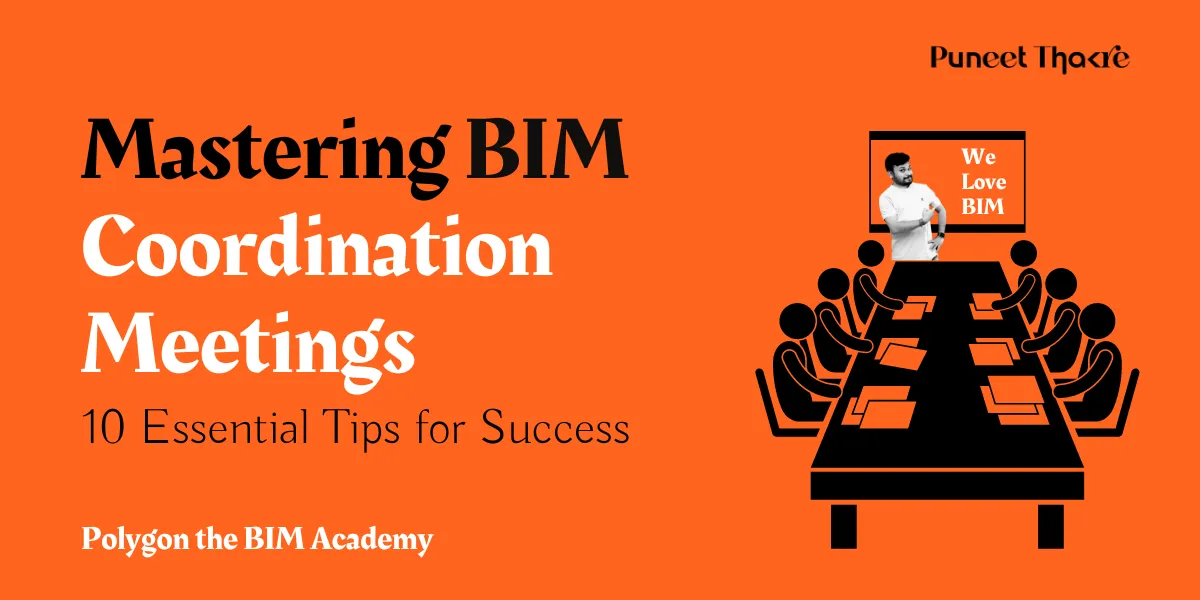#BIM Coordination Meeting
Hello Architects & AEC Enthusiasts!
Running a successful BIM coordination meeting requires more than just setting a date and sending out invites. It involves careful planning, effective communication, and strategic problem-solving. In this article, we will delve into essential tips and best practices that can help you navigate through the complexities of BIM coordination effortlessly.
Introduction: Elevating Your BIM Coordination Meetings
In the complex landscape of construction and design, BIM (Building Information Modeling) coordination meetings represent a pivotal moment for interdisciplinary collaboration and problem-solving. These meetings, when effectively managed, can significantly enhance project efficiency, minimize errors, and align diverse team members towards common goals. However, the challenge lies in conducting these meetings in a manner that is both structured and dynamic, ensuring meaningful participation and actionable outcomes. This article aims to equip leaders and participants with strategic insights for optimizing BIM coordination meetings, ensuring they contribute positively to project timelines and quality. Let's explore the 10 essential tips that will elevate your BIM coordination meetings from obligatory gatherings to strategic, outcome-oriented sessions.
1. Establish Clear Objectives Beforehand
The foundation of a successful BIM coordination meeting lies in its preparation phase. It's essential to establish clear, achievable objectives well in advance. This proactive step involves a deep dive into the specifics of what the meeting aims to achieve. Whether it's to resolve conflicts within the BIM model, align on project milestones, or address specific design challenges, having well-defined goals sets the stage for a focused and outcome-driven meeting. It directs the conversation, ensuring that every discussion point directly contributes to meeting these predefined objectives, thereby maximizing the productivity of the session.
2. Prepare and Distribute the Agenda Early
Think of the agenda as the backbone of your BIM coordination meeting. A well-constructed agenda, shared with participants ahead of time, acts as a crucial tool for ensuring an organized and effective discussion. It should outline the topics of discussion, allocate time for each segment, and identify lead discussants or presenters for various sections. By providing participants with this roadmap, you empower them to prepare thoroughly, fostering a more dynamic and engaging meeting environment where everyone is ready to contribute their insights and solutions.
3. Leverage the Right BIM Tools
The success of a BIM coordination meeting significantly depends on the technology employed. Utilizing advanced BIM software that supports real-time collaboration and model sharing is non-negotiable. Platforms like Autodesk Revit, Navisworks, & Autodesk Construction Cloud (former BIM 360) offer functionalities that can dramatically improve the efficiency of your meetings. These tools not only facilitate a better understanding and visualization of the project but also streamline the identification and resolution of issues. Choosing the right BIM tools can transform your coordination meetings into highly productive sessions where technical challenges are addressed with precision.
4. Promote Open Communication
Creating a meeting culture that encourages open communication is critical. It's important to foster an environment where all participants feel valued and free to express their ideas, concerns, and suggestions. This approach cultivates a collaborative atmosphere, essential for the iterative nature of design and construction projects. Embrace the diversity of perspectives, as it often leads to innovative solutions and enhances the collective problem-solving capacity of the team. Remember, a successful BIM coordination meeting is one where dialogue flows freely, and every voice is heard.
5. Assign Roles and Responsibilities
Efficiency during and after the meeting is greatly enhanced by clear delineation of roles and responsibilities. Assigning specific tasks, such as facilitating the discussion, taking notes, and leading certain agenda items, ensures that the meeting progresses smoothly and that important information and decisions are accurately recorded and actioned. This level of organization also promotes accountability, as each participant understands their contribution to the meeting's success and the project's progression. Ensuring that roles are clearly defined and communicated prevents overlaps and omissions, paving the way for a more streamlined and effective meeting outcome.
6. Focus on Problem-Solving, Not Blame
When navigating the complexities of BIM coordination, it's inevitable that issues will surface. The key to a productive meeting lies in addressing these challenges with a solution-oriented mindset. Prioritize identifying viable solutions over finding fault. This approach not only maintains a positive atmosphere but also encourages active participation from all members. When the team focuses on problem-solving rather than assigning blame, it paves the way for innovative solutions and strengthens team cohesion, leading to more constructive outcomes and a culture of accountability and collaboration.
7. Utilize Visuals to Enhance Understanding
In the realm of BIM coordination, visuals are invaluable. Leveraging 3D models, diagrams, and charts can transform abstract concepts into tangible visuals, making complex ideas easier to grasp. This use of visuals aids in bridging the gap between different disciplines, ensuring that all stakeholders have a clear understanding of the project aspects being discussed. Enhanced visualization leads to more efficient decision-making processes, as team members are better equipped to assess information and contribute to discussions meaningfully.
8. Keep the Meeting Concise
Efficiency is paramount in BIM coordination meetings. Respecting the time of all participants means ensuring that discussions are both productive and time-bound. Adhering strictly to the agenda and allocated times for each topic helps in maintaining focus and prevents the meeting from veering off course. If certain issues require more extensive deliberation, opt for scheduling targeted follow-up sessions. This approach ensures that meetings remain effective and decisive, valuing everyone's time and keeping the project on track.
9. Follow Up with Clear Action Items
The true measure of a meeting's success is in the follow-through. Conclude each meeting with a clear summary of the decisions made and outline specific action items, assigning responsible individuals and deadlines for each task. This clarity in post-meeting communication is crucial for maintaining momentum. Promptly distributing a summary of these points ensures that all team members are aligned on their responsibilities and the project's next steps, facilitating continuous progress toward project goals.
10. Continuously Improve Your Process
Every BIM coordination meeting offers a unique opportunity for process enhancement. Actively seek feedback from participants regarding the meeting's efficiency, engagement, and outcomes. This feedback is invaluable for identifying areas of strength and opportunities for improvement. Embracing a culture of continuous improvement ensures that each meeting is more effective than the last, fostering a dynamic environment that adapts and evolves to meet the project's needs efficiently.
In Conclusion
Mastering the art of leading BIM coordination meetings is about more than just agenda-setting and discussion facilitation. It's about creating an environment where collaboration thrives, problems are approached constructively, and every meeting contributes to the forward momentum of the project. By implementing these ten strategies, you position your meetings as a cornerstone of project success, ensuring they serve as productive, efficient, and valuable gatherings that drive your projects to their successful completion.
FAQs
Q: How often should BIM coordination meetings be held?
A: The frequency of BIM coordination meetings should be determined by the project's complexity and phase. Weekly meetings are common, but this can vary.
Q: Can BIM coordination meetings be held virtually?
A: Yes, with the right tools and preparation, virtual BIM coordination meetings can be just as effective as in-person sessions.
Q: How do you ensure all team members can contribute during the meeting?
A: Encourage participation by asking direct questions, using round-robin techniques, and fostering an inclusive atmosphere where all opinions are valued.
Q: What is the role of a BIM coordinator in a coordination meeting?
A: A BIM coordinator is responsible for overseeing the coordination process, resolving clashes, managing the MEP workflow, and ensuring an effective BIM coordination meeting.
Q: How can I ensure my BIM coordination meetings are effective?
A: To run effective BIM coordination meetings, have a clear agenda, invite relevant team members, stick to the schedule, and follow up on action items to ensure productivity.
Q: Why is the BIM execution plan important for running successful coordination meetings?
A: The BIM execution plan outlines the BIM coordination process, including roles and responsibilities, which is essential for orchestrating smooth and productive coordination meetings.
Q: Why do I need to hold weekly BIM coordination meetings?
A: Weekly BIM coordination meetings help keep the project on track, address new clashes promptly, and maintain a productive meeting rhythm that supports the whole BIM process.
Q: What can I do if I can't run efficient coordination meetings?
A: If you're running into challenges with running efficient coordination meetings, consider refining your meeting processes, improving communication among team members, and seeking feedback on how to conduct better BIM coordination meetings.
By incorporating these strategies, you'll not only enhance the efficiency and effectiveness of your BIM coordination meetings but also contribute significantly to the success of your construction and design projects.
I'd love to hear from you!
Do you have additional tips that have transformed your BIM coordination meetings? Perhaps you've faced challenges that required creative solutions? Share your experiences and insights in the comments below. Your contribution not only enriches the conversation but also helps us all grow and improve our practices in this dynamic field.
Together, let's continue to push the boundaries of what effective BIM coordination can achieve, ensuring our projects not only meet but exceed expectations.
Your thoughts and experiences are invaluable—let's learn from each other and build a stronger, more connected BIM community. Comment below with your takeaways, questions, or any nuggets of wisdom you've picked up along your BIM journey.





